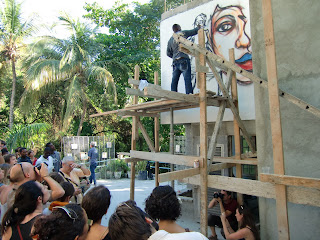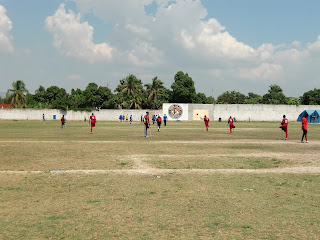Throughout our time in Haiti Al and I have had frequent conversations around the topic of 'how will we know when our work here is done?' and 'what does success look like in the humanitarian world?'. I continue to believe that we should work ourselves out of a job. That as soon as we have raised the capabilities of our national counterparts and have transferred whatever unique knowledge we possess - we should be replaced by a Haitian worker and our time should be done.
Mixed in with that is the pull of family and friends and the reality that this is the only life we are get...I'm been sad to miss so many milestones. All that said, I felt my team was getting close to taking over for me so I started asking around about job options in the U.S. and fairly quickly found a great job with a company I know and trust in NYC working with colleagues from my past. I resigned my Haitian position feeling a little uncertain, that maybe I was leaving too soon.
Then came Friday of last week. The most rewarding day of my work life to date (I'm looking forward to more!). I have always been lucky in work, and even more so here. I report to an amazing man and work for an organization that I admire. Last Spring I told my supervisor that I didn't think we were working with the most vulnerable in Port au Prince and I thought we could do more. He listened and asked me to write the program I thought could work, then to turn it into a proposal. I received funding which means - all hands on deck - you're approved and now you get to bring your idea to life! My program name is Ann Ale Lakay, Kreyol for Let's Go Home. Since arriving in Haiti, I've been working on Resettlement (trying to get people to leave the tent camps which were spontaneously created after the earthquake and move back to their neighborhoods). First we worked in the camps, providing immediate disaster relief. Then we moved to the neighborhoods, trying a pull strategy. The thinking was that if we leave the camps and move to the neighborhoods, the people will follow.
It worked for many, but with 125,000 very vulnerable families still living in camps, Ann Ale Lakay was a plan created to provide monetary assistance for people to leave the camps AFTER they fulfilled their end of the deal - completing a six week life skills training program. The small group training, led by Haitian University graduated Social Workers and Psychologists included: Communications, Conflict Resolution, Personal Responsibility, Needs Assessment and Financial Basics. After completion, each family worked one on one with their Social Worker to write their own Family Plan. They detailed their needs based on priority and created solutions for each.
We entered our first camp about nine weeks ago. We were met with anger, frustration and fear. The residents felt abandoned in the aftermath of aid organizations trying the pull strategy in neighborhoods, and while not the best living conditions, many people hadn't allowed themselves to think past a permanent camp existence. That first day in the camp I knew I had a team of people that could take over what I'd created. They jumped right in with compassion and tremendous listening skills. Since that day the atmosphere in the camp has changed to hope and joy. Every family has found a new home. Each day I see families washing their belongings and dismantling their camp homes. The families that haven't yet moved are anxious to go. By Friday, December 9th, which happens to by my last day of work here, the camp should be completely empty. I am SO proud of my team!
Finally, what happened on Friday...
I arrived at the camp to see one of the women that I remember being amongst the angriest and most bitter on our first day. I was invited to visit her in her new home. I wasn't quite sure what to expect, but as soon as she opened the gate to her home a huge smile spread across her face. She introduced me to her husband and two teenage sons. She then proceeded to tell me how much the Ann Ale Lakay program has changed her life. She cited the training as the catalyst to allow her and her husband to reconcile and enjoy each other again. She said she has been able to let go of her anger and find something to celebrate every day. She said she loves waking up to life outside the camp and most of all she pointed out their Family Plan, which she says will guide them and has enabled them to take back control of their own lives. This is sustainable change.
And after all, isn't that what everyone on earth should have? The dignity and self respect to get up every morning and feel hope and find some part of our day that brings a smile to our face that we can share with others?
I could stop here, except it gets better. I left her home, feeling far more gratitude towards her than my language abilities would allow me to explain or that she might ever understand to go to the Healing Hands tree topping ceremony for the new handicap accessible Outpatient Physical Medicine and Rehabilitation Center. After the clinic was torn down post earthquake Al was able to find generous donors in the International Committee of the Red Cross, American Red Cross, Australian Red Cross and Norwegian Red Cross. They agreed to work together to fund this new building. Friday was the day that the final cement was poured on the roof of the structure. WOW! It's been fun to watch it go up - by a Haitian construction firm that has been supervised by a French Engineer - and watching Al scoop a ceremonial shovel of cement was incredible. The culmination of his passion for rehab in Haiti over the last eight years will stand to serve the disabled community for a very long time.
And so, after much uncertainty about whether or not now is the time to leave I can say that I feel good about the work I have done here. The frustrations, injustices and inhumanity witnessed, tears shed and sleepless nights were in the end definitely worth it.
 |
| Arriving home |
 |
| Kids helped to pack |
 |
| Getting everything ready to leave the camp |
 |
| Moving Day |
 |
| New Healing Hands Orthopedic & Physical Medicine Center - Opening to Patients in March or April 2012 |
 |
| Al adding the last shovelful of cement to the top of the building |













































